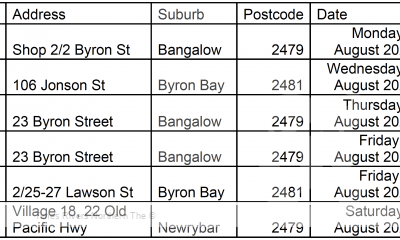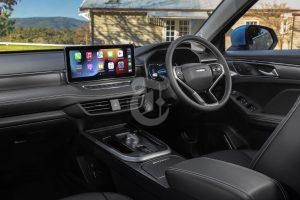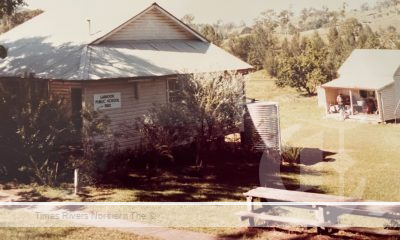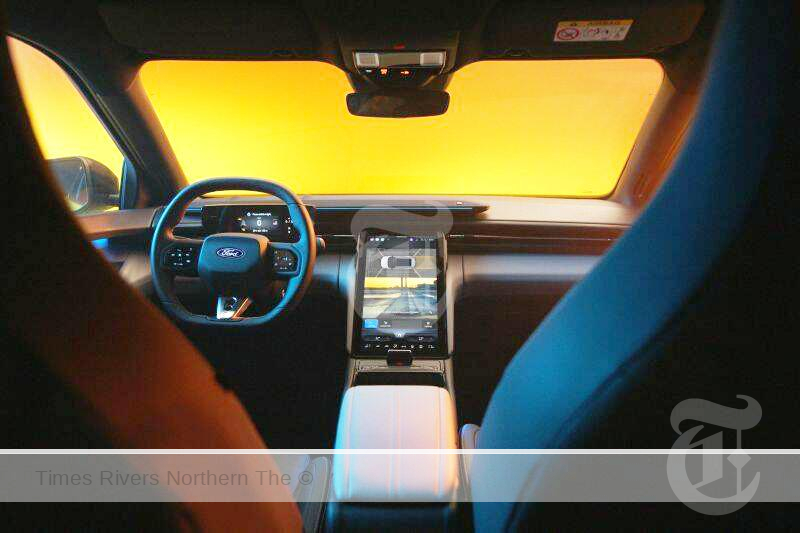JOLION HYBRID QUICK TO MAKE UP FOR HIP-POCKET HIT
By DEREK OGDEN
The Haval Jolion has joined the EV set with its Ultra Hybrid model
Jolion has jumped on to the small-to-medium electric sports utility vehicle bandwagon with a petrol / electric hybrid topping out the range as the single specification Ultra model.
With a starting price of $40,990 drive away, $7000 more than its equivalent petrol sibling, the Chinese Great Wall Motors sourced-Haval Ultra is at odds with its economic running cost raison d’etre.
There are, however, some sweeteners. The hybrid Ultra has unique features such as a new front grille, LED lamps and fog lights with blue accents, and bumper, a new rear spoiler and 18-inch alloy wheels over the petrol Jolion Ultra.
The hybrid requires servicing every 12 months or 15,000 kilometres, whichever comes first. Haval includes five years of capped-price servicing that adds up to $1550 for maintenance.
STYLING
Visual differences between the Jolion petrol and Hybrid include new front and rear bumpers, a new front grille, blue accents in the front fog lights, a sportier rear spoiler, and a new design for the 18-inch wheels.
Unlocking the car with the key fob has the hybrid putting on a light show up front, with flickering and flashing like a Times Square ad strip. A bit embarrassing in the executive car park? This spotlight falls brightly on a grille with sparkling finish and horizontal accents to create a bold, if flashy, show.
The car’s profile is standard SUV lines with a coupe-like roof curve approaching the C-pillar. The rear is as plain as the front is flashy.
INTERIOR
Faux leather seating is good enough to give the impression of the luxury of the real thing but some hard plastic surfaces bring things back down to earth.
Thanks to a long wheelbase the bench-like back seat accommodates three across with generous legroom and there is no centre raised tunnel to produce knees-up discomfort in the centre spot. Headroom is compromised by the sloping roofline and sunroof.
Storage is taken care of by a central bin and a pair of cup holders in two sizes in the centre console, while door pockets can fit bottles.
Boot space checks in at 390 litres, 40 litres down on the petrol model due to electrical workings, expanding to 1069 litres with the 60:40 second row stowed.
INFOTAINMENT
A 12.3-inch touchscreen crowns the central dashboard and a 7-inch digital display sits directly in front of the driver. Topping this off is a head-up windscreen display featuring digital speedo and speed limits.
Connectivity consists of the 12.3-inch colour multimedia touchscreen linked to Apple CarPlay or Android Auto. Audio is handled by a six-speaker system, while dual-zone air-conditioning keeps occupants in relative comfort.
It may be way past 1984 but the Jolion driver has a ‘Big Brother’ to check he or she is paying attention to matters at hand. A camera fixed to the A-pillar serves up an audible ding and the admonishment ‘Hey, don’t stray!’ on the touchscreen on catching what it thinks is concentration wavering. It’s all a bit, well, Chinese.
ENGINES / TRANSMISSIONS
The Haval Jolion Hybrid is powered by a 1.5-litre turbocharged four-cylinder petrol engine hitched up to GWM’s two-speed Direct Hybrid Transmission, driving through the front wheels. Incorporating an electric motor, combined output is 139 kW and 375 Nm.

SAFETY
Standard safety features include seven airbags including front-centre, autonomous emergency braking with pedestrian and cyclist detection.
There’s lane keeping assist, blind spot monitoring, traffic sign recognition, rear cross-traffic alert, adaptive cruise control with stop / go and safe exit warning.
Cameras create an all-round plan view of the vehicle, while Haval’s one-eyed monster camera keeps a check of the driver’s behaviour behind the wheel.
DRIVING
The hybrid Jolion offers a number of drive modes – EV, allowing full electric driving; Series, which uses the petrol engine to generate power for the electric motor and battery; Parallel, which runs petrol and electric power together; and Regeneration, concentrating the electric motor’s regenerative braking function, recouping energy.
It’s not possible to move manually between modes, Jolion Ultra Hybrid assuming it can do things better than the mere mortal behind the wheel.
Sending power to the front wheels, GWM claims a combined fuel consumption of 5.0 litres per 100km for the Jolion Hybrid – down from 8.1 litres per 100 kilometres in the petrol Jolion – with regular 91RON unleaded.
The test vehicle turned in 6.9 litres per 100 kilometres on a range of driving in city and suburbs.
A series of drive modes – normal, sport, economy and snowfield – or one-pedal operation are accessed via the touchscreen – not the easiest while on the move
This latter function allows the driver to use the accelerator pedal only, easing off has the vehicle braking automatically.
The screen’s spot on the centre dash of the test car also had its problems, with
air-con controls underneath easy to catch accidentally while resting the palm on working the screen.
SUMMARY
Despite the $7000 price penalty over the petrol Jolion, the Ultra HEV could turn out to be a real worry for Toyota RAV4 and Kia Niro EV competitors. And shorter wait lists are a big bonus for buyers.
RATINGS
Looks: 7/10
Performance: 6/10
Safety: 7/10
Thirst: 5/10
Practicality: 6/10
Comfort: 6/10
Tech: 8/10
Value: 6/10
AT A GLANCE
MODEL LINE-UP
Haval Jolion Premium: $28,490
Haval Jolion Lux: $30,990
Haval Jolion Ultra: $33,990
Haval Jolion Ultra Hybrid: $40,990
Note: These prices are drive-away.
SPECIFICATIONS (Haval Jolion Civic Ultra 1.5L turbocharged 4-cylinder petrol, electric motor, 1.76 kWh battery, 2sp automatic, FWD)
ENGINE:
Capacity: 1.497 litres
Configuration: Four cylinders inline
Combined Maximum Power: 139 kW
Combined Maximum Torque: 375 Nm
Fuel Type: Regular unleaded petrol
Combined Fuel Cycle (ADR 81/02): 5.0 L/100km
CO2 emissions 116 g/km
DRIVELINE: Two-speed automatic, front-wheel drive





 Tweed Shire News2 years ago
Tweed Shire News2 years ago
 Motoring News1 year ago
Motoring News1 year ago
 COVID-19 Northern Rivers News3 years ago
COVID-19 Northern Rivers News3 years ago
 COVID-19 Northern Rivers News3 years ago
COVID-19 Northern Rivers News3 years ago
 Northern Rivers Local News3 years ago
Northern Rivers Local News3 years ago
 Health News3 years ago
Health News3 years ago
 COVID-19 Northern Rivers News3 years ago
COVID-19 Northern Rivers News3 years ago
 NSW Breaking News3 years ago
NSW Breaking News3 years ago































